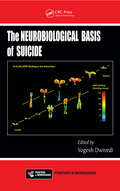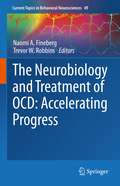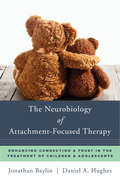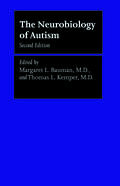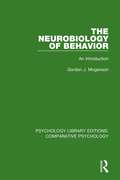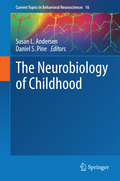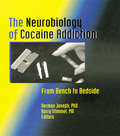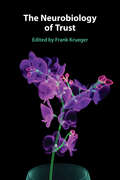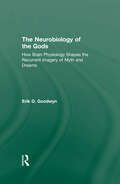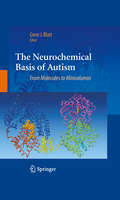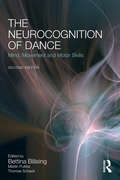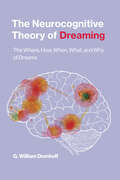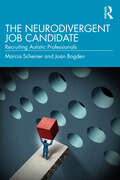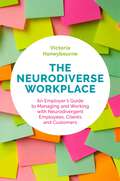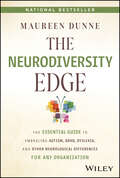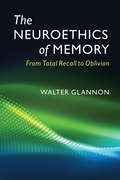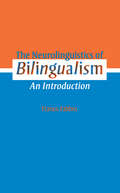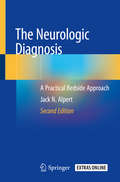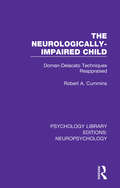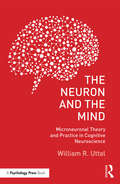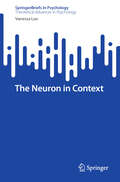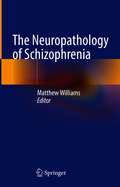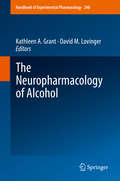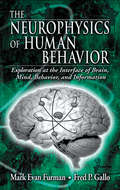- Table View
- List View
The Neurobiological Basis of Suicide
by Yogesh DwivediWith recent studies using genetic, epigenetic, and other molecular and neurochemical approaches, a new era has begun in understanding pathophysiology of suicide. Emerging evidence suggests that neurobiological factors are not only critical in providing potential risk factors but also provide a promising approach to develop more effective treatment
The Neurobiology and Treatment of OCD: Accelerating Progress (Current Topics in Behavioral Neurosciences #49)
by Trevor W. Robbins Naomi A. FinebergThe book highlights important new research approaches of clinical relevance, written by prominent researchers in the field of OCD and related disorders. A broad range of topics is covered, beginning with a description of the phenotypic features of the OCD followed by chapters on developmental aspects, animal models, genetic and biological models including neuro-inflammation, functional neuroimaging correlates and information-processing accounts. Finally, existing and novel treatment approaches are covered including clinical and pharmacogenetic treatment models. In this way the volume brings together the key disciplines involved in the neurobiological understanding of OCD to provide an update of the field and outlook to the future. Together, the volume chapters provide focused and critical reviews that span a broad range of topics suitable for both students and established investigators and clinicians interested in the present state of OCD research.
The Neurobiology of Attachment-Focused Therapy: Enhancing Connection & Trust in the Treatment of Children & Adolescents (Norton Series on Interpersonal Neurobiology)
by Daniel A. Hughes Jonathan BaylinUniting attachment-focused therapy and neurobiology to help distrustful and traumatized children revive a sense of trust and connection. How can therapists and caregivers help maltreated children recover what they were born with: the potential to experience the safety, comfort, and joy of having trustworthy, loving adults in their lives? This groundbreaking book explores, for the first time, how the attachment-focused family therapy model can respond to this question at a neural level. It is a rich, accessible investigation of the brain science of early childhood and developmental trauma. Each chapter offers clinicians new insights--and powerful new methods--to help neglected and insecurely attached children regain a sense of safety and security with caring adults. Throughout, vibrant clinical vignettes drawn from the authors' own experience illustrate how informed clinical processes can promote positive change. Authors Baylin and Hughes have collaborated for many years on the treatment of maltreated children and their caregivers. Both experienced psychologists, their shared project has bee the development of the science-based model of attachment-focused therapy in this book--a model that links clinical interventions to the crucial underlying processes of trust, mistrust, and trust building--helping children learn to trust caregivers and caregivers to be the "trust builders" these children need. The book begins by explaining the neurobiology of blocked trust, using the latest social neuroscience to show how the child's early development gets channeled into a core strategy of defensive living. Subsequent chapters address, among other valuable subjects, how new research on behavioral epigenetics has shown ways that highly stressful early life experiences affect brain development through patterns of gene expression, adapting the child's brain for mistrust rather than trust, and what it means for treatment approaches. Finally, readers will learn what goes on in the child's brain during attachment-focused therapy, honing in on the dyadic processes of adult-child interaction that seem to embody the core "mechanisms of change": elements of attachment-focused interventions that target the child's defensive brain, calm this system, and reopen the child's potential to learn from new experiences with caring adults, and that it is safe to depend upon them. If trust is to develop and care is to be restored, clinicians need to know what prevents the development of trust in the first place, particularly when a child is living in an environment of good care for a long period of time. What do abuse and neglect do to the development of children's brains that makes it so difficult for them to trust adults who are so different from those who hurt them? This book presents a brain-based understanding that professionals can apply to answering these questions and encouraging the development of healthy trust.
The Neurobiology of Autism (The Johns Hopkins Series in Psychiatry and Neuroscience)
by Margaret L. BaumanIn the decade since the first edition of The Neurobiology of Autism was published, research has revealed valuable new information about the nature and origins of autism, including genetics and abnormalities in such neurotransmitters as acetylcholine and serotonin. For this long-anticipated new edition, neurologists Margaret L. Bauman and Thomas L. Kemper bring together leading researchers and clinicians to present the most current scientific knowledge and theories about autism. The contributors cover genetics, imaging studies, physiology, neuroanatomy and neurochemistry, immunology, brain function, the epidemiology of the disease, and related disorders. Thoroughly updated, The Neurobiology of Autism remains the best single-volume work on the wide array of research being conducted into the causes, characteristics, and treatment of autism.Contributors: George M. Anderson, Yale Child Study Center; Tara L. Arndt, University of Rochester Medical Center (URMC); Trang Au, University of Massachusetts Medical School (UMMC); Jocelyne Bachevalier, University of Texas Health Science Center; Irina N. Bespalova, Seaver Autism Research Center, Mt. Sinai School of Medicine (SARC); Gene J. Blatt, Boston University School of Medicine (BUSM); Susan E. Bryson, IWK Health Centre–Dalhousie University; Timothy M. Buie, Massachusetts General Hospital (MGH); Joseph D. Buxbaum, SARC; Kathryn M. Carbone, The Johns Hopkins University School of Medicine (JHUSM); Diane C. Chugani, Wayne State University; Daniel F. Connor, UMMC; Edwin H. Cook, Jr., University of Chicago; S. Hossein Fatemi, University of Minnesota Medical School; Susan E. Folstein, Tufts University School of Medicine; Eric Fombonne, McGill University; Randi Jenssen Hagerman, UC Davis Medical Center; Elizabeth Petri Henske, Fox Chase Cancer Center, Philadelphia; Jeannette J. A. Holden, Queen's University; Ronald J. Killiany, BUSM; Omanand Koul, UMMC; Mandy Lee, Newcastle General Hospital, U.K.; Xudong Liu, Queen's University; Tara L. Moore, BUSM; Mark B. Moss, BUSM; Karin B. Nelson, National Institute of Neurological Disorders and Stroke; Phillip G. Nelson, National Institute of Child Health and Human Development; Elaine Perry, Newcastle General Hospital; Jonathan Pevsner, JHUSM; Mikhail V. Pletnikov, JHUSM; Stephen W. Porges, University of Illinois at Chicago; Lucio Rehbein, Universidad de la Frontera, Chile; Jennifer Reichert, SARC; Patricia M. Rodier, URMC; Beth Rosen-Sheidley, MGH; Susan L. Smalley, UCLA Neuropsychiatric Research Institute; Ronald J. Steingard, UMMC; Helen Tager-Flusberg, BUSM; Gary L. Wenk, University of Arizona; Andrew W. Zimmerman, JHUSM
The Neurobiology of Behavior: An Introduction (Psychology Library Editions: Comparative Psychology)
by Gordon J. MogensonOriginally published in 1977, the objective of this book was to examine the mechanisms by which the multiple factors or determinants – homeostatic deficits, hormonal influences, circadian rhythms, experiential and cognitive factors – become translated by the central nervous system into thermoregulatory, feeding, sexual, aggressive, and other behaviours. A conceptual framework has been used that reflects relevant contributions from biology, regulatory physiology, physiological psychology, and other neuroscience disciplines. The final chapter deals with difficulties in brain-behaviour research in relation to experimental strategies and with crucial problems for future investigation.
The Neurobiology of Childhood
by Susan L. Andersen Daniel S. PineDuring the past years there has been rapid progress in the understanding of how early life stress impacts psychopathology in children. The first two parts of this book present the basic principles of brain development and describe the most important neuronal systems This includes systems involved in emotion processing, cognitive control, and social processes These first two general sections are followed by an overview about recent research on various neuronal and psychiatric disorders, where environmental exposures and altered brain development play an important role: sleep, autism, ADHD and other developmental forms of psychopathology.
The Neurobiology of Childhood (Current Topics in Behavioral Neurosciences #16)
by Susan L. Andersen and Daniel S. PineDuring the past years there has been rapid progress in the understanding of how early life stress impacts psychopathology in children. The first two parts of this book present the basic principles of brain development and describe the most important neuronal systems. This includes systems involved in emotion processing, cognitive control, and social processes. These first two general sections are followed by an overview about recent research on various neuronal and psychiatric disorders, where environmental exposures and altered brain development play an important role: sleep, autism, ADHD and other developmental forms of psychopathology.
The Neurobiology of Cocaine Addiction: From Bench to Bedside
by Herman Joseph Regina QuattrochiWith the use of crack on the rise in American cities, there is more need than ever to understand the biological, environmental, and social factors behind cocaine addiction, as well as the pharmacological properties of cocaine that make it such an addictive drug. The Neurobiology of Cocaine Addiction helps clinicians and researchers analyze research findings and their relevance to the clinical treatment of cocaine dependency. To do this, it looks at the whole spectrum of cocaine use, from trends in cocaine-involved deaths, hospital emergencies, arrests, and treatment admissions to the specific impact the drug has on brain function. The book reports on important findings from positron emission tomography (PET) and a “binge” pattern cocaine administration mode. This will enable you to improve your understanding of how cocaine alters the pleasure/reward system of the brain and creates new instinctual needs that displace the inherent instinctual needs of hunger and sex.By reading The Neurobiology of Cocaine Addiction, you will sharpen your knowledge of the basic actions of cocaine, the factors related to daily cocaine use, the neurobiological basis of addictive diseases, and drug-induced alterations in normal physiology. You will also learn about: the coexistence of cocaine and heroin addiction cocaine&’s disruption of the endogenous opioid system QEEG and how it can play a potentially useful role in drug development and planning hypotheses of sensitization in the pathophysiology of cocaine dependence factors that predict daily cocaine use among patients in a methadone maintenance program abnormalities in brain function that persist for up to six months after last cocaine use patterns of cocaine use the importance of prospective data analysis and the limitations of a self-selective study groupClinicians, researchers, psychiatrists, and other professionals in chemical dependency and narcotics rehabilitation will turn the last page of The Neurobiology of Cocaine Addiction with a better understanding of cocaine&’s addictive qualities and the characteristics of the individuals who become addicted to it. You will see what headway has been made in research at some of the nation&’s top laboratories, but you will also see what remains to be done. Hopefully, you will find where you can make a contribution either at the practical level, the research level, or both.
The Neurobiology of Trust
by Frank KruegerTrust is essential for establishing and maintaining cooperative behaviors between individuals and institutions in a wide variety of social, economic, and political contexts. This book explores trust through the lens of neurobiology, focusing on empirical, methodological, and theoretical aspects. Written by a distinguished group of researchers from economics, psychology, human factors, neuroscience, and psychiatry, the chapters shed light on the neurobiological underpinnings of trust as applied in a variety of domains. Researchers and students will discover a refined understanding of trust by delving into the essential topics in this area of study outlined by leading experts.
The Neurobiology of the Gods: How Brain Physiology Shapes the Recurrent Imagery of Myth and Dreams
by Erik D. GoodwynWhere does science end and religion begin? Can "spiritual" images and feelings be understood on a neurobiological level without dismissing their power and mystery? In this book, psychiatrist Erik Goodwyn addresses these questions by reviewing decades of research, putting together a compelling argument that the emotional imagery of myth and dreams can be traced to our deep brain physiology, and importantly, how a sensitive look at this data reveals why mythic or religious symbols are indeed more "godlike" than we might have imagined. The Neurobiology of the Gods weaves together Jungian depth psychology with research in evolutionary psychology, neuroanatomy, cognitive science, neuroscience, anthropology, mental imagery, dream research, and metaphor theory into a comprehensive model of how our brains contribute to the recurrent images of dreams, myth, religion and even hallucinations. Divided into three sections, this book provides: definitions and foundations an examination of individual symbols conclusive thoughts on how brain physiology shapes the recurring images that we experience. Goodwyn shows how common dream, myth and religious experiences can be meaningful and purposeful without discarding scientific rigor. The Neurobiology of the Gods will therefore be essential reading for Jungian analysts and psychologists as well as those with an interest in philosophy, anthropology and the interface between science and religion.
The Neurochemical Basis of Autism
by Gene J. BlattThe Neurochemical Basis of Autism: From Molecules to Minicolumns is a uniquely interdisciplinary text that presents the latest findings regarding the physiological, neuropathological, neurochemical and clinical elements of autism. This book contains an array of unique perspectives on autism from top researchers, beginning with a clinical perspective that discusses etiologies, early identification, advancements in care and associated disorders. It then covers topics such as neuropathological changes in autism to the pre- and post-natal development timing of the disorder, changes in the cerebellum in autism, the role of oxytocin in autism, the relationship of oxidative stress and autism, and a comprehensive review of pharmacotherapies, as well as the hypotheses being used to explore its causes and cures. Lay abstracts make this book as accessible to the parents and caretakers of autistic children as it is indispensable to the scientists, researchers and clinicians on the front line of this affliction.
The Neurocognition of Dance: Mind, Movement and Motor Skills
by Bettina Bläsing Martin Puttke Thomas SchackDance has always been an important aspect of all human cultures, and the study of human movement and action has become a topic of increasing relevance over the last decade, bringing dance into the focus of the cognitive sciences. Since the first edition of The Neurocognition of Dance was published, research into the cognitive science of dance has expanded extensively, with the number of scientific studies focusing on dance and dance-related topics in cognitive psychology growing significantly. Featuring three new chapters addressing topics that have become highly relevant to the field in recent years – neuroaesthetics, entrainment, and choreographic cognition – as well as progress in teaching based on novel methods, this comprehensively revised and updated new edition of The Neurocognition of Dance is full of cutting-edge insights from scientists, researchers, and professionals from the world of dance. Also now including online material such as links to video clips, colour images and hands-on material for practical application, this book is an essential companion for students and professionals from fields including dance, cognitive psychology, sport psychology and sport science, movement science, and cognitive robotics.
The Neurocognitive Theory of Dreaming: The Where, How, When, What, and Why of Dreams
by G. William DomhoffA comprehensive neurocognitive theory of dreaming based on the theories, methodologies, and findings of cognitive neuroscience and the psychological sciences.G. William Domhoff&’s neurocognitive theory of dreaming is the only theory of dreaming that makes full use of the new neuroimaging findings on all forms of spontaneous thought and shows how well they explain the results of rigorous quantitative studies of dream content. Domhoff identifies five separate issues—neural substrates, cognitive processes, the psychological meaning of dream content, evolutionarily adaptive functions, and historically invented cultural uses—and then explores how they are intertwined. He also discusses the degree to which there is symbolism in dreams, the development of dreaming in children, and the relative frequency of emotions in the dreams of children and adults. During dreaming, the neural substrates that support waking sensory input, task-oriented thinking, and movement are relatively deactivated. Domhoff presents the conditions that have to be fulfilled before dreaming can occur spontaneously. He describes the specific cognitive processes supported by the neural substrate of dreaming and then looks at dream reports of research participants. The &“why&” of dreaming, he says, may be the most counterintuitive outcome of empirical dream research. Though the question is usually framed in terms of adaptation, there is no positive evidence for an adaptive theory of dreaming. Research by anthropologists, historians, and comparative religion scholars, however, suggests that dreaming has psychological and cultural uses, with the most important of these found in religious ceremonies and healing practices. Finally, he offers suggestions for how future dream studies might take advantage of new technologies, including smart phones.
The Neurodivergent Job Candidate: Recruiting Autistic Professionals
by Joan Bogden Marcia ScheinerThis book provides guidance on recruiting, interviewing, and onboarding practices that will allow employers to successfully hire neurodivergent professionals into inclusive, competitive employment. Today, 35% of 18-year-olds with an autism spectrum diagnosis attend college, yet they have a 75–85% under-employment and unemployment rate after graduation. While organizations are looking to expand their diversity and inclusion hiring efforts to include neurodivergent professionals, current recruiting and interviewing practices in general are not well-suited to this. With over one-third of the US population identifying as neurodivergent, employers need to address how to attract this talent pool to take advantage of a meaningful segment of the workforce. Readers of this book will gain an understanding of how to guide their organizations through the creation of recruiting, interviewing, and onboarding processes tailored to neurodivergent professionals in any field. Written by authors with extensive experience working in the corporate world and consulting with Fortune 1000 companies on autism hiring efforts, this book is targeted at employers, acknowledging their perspective. Structured as a reference guide for busy recruiters, hiring managers, and supervisors, this book can be read in its entirety, in relevant sections as needed, or used as a refresher whenever necessary. This book also provides a background on the thinking styles of autistic individuals, giving the reader a deeper understanding of how to best support neurodivergent jobseekers.
The Neurodiverse Workplace: An Employer’s Guide to Managing and Working with Neurodivergent Employees, Clients and Customers
by Victoria HoneybourneEstimates suggest that up to 20% of employees, customers and clients might have a neurodivergent condition - such as dyslexia, autism, Asperger's, ADHD or dyspraxia - yet these individuals often struggle to gain and maintain employment, despite being very capable. This practical, authoritative business guide will help managers and employers support neurodiverse staff, and gives advice on how to ensure workplaces are neuro-friendly. The book demonstrates that neurodiversity is a natural aspect of human variation to be expected and accepted, rather than a deficit to be accommodated. Employer responsibilities are highlighted, including the 2010 Equality Act, and a range of strategies and policies are provided, including recruitment advice and the benefits of neurodiverse employees, along with advice on physical environments, interaction and communication, and working with clients and customers. This book is an ideal resource for all employers wanting to support and empower people with specific needs to help create a more inclusive workplace, benefiting both neurodiverse individuals and the companies employing them.
The Neurodiversity Edge: The Essential Guide to Embracing Autism, ADHD, Dyslexia, and Other Neurological Differences for Any Organization
by Maureen DunneIn The Neurodiversity Edge, renowned Oxford-trained cognitive scientist, neurodiversity expert, and business leader, Dr. Maureen Dunne presents a pioneering framework to harnessing the power of neurodiversity to navigate the most important human resources revolution in the modern era. Did you know that an estimated 1 in 5 people are “neurodivergent”—have a mind that works differently, such as the autistic, ADHDers, the dyslexic, synesthetes, and other unique neurotypes—and that the vast majority are motivated, capable, and unemployed? This indispensable guide is based on more than two decades of immersive cognitive science research, case studies, stories from neurodivergent voices, in-the-trenches work with hundreds of organizations from start-ups to global Fortune 500 titans, and Dr. Dunne's own lived experiences as a neurodivergent employer, entrepreneur, board member, and CEO. Too many unique minds and perspectives on the sidelines, and too many organizations beset by groupthink, innovation-stagnation, and a lack of access to qualified new candidates. The Neurodiversity Edge takes you all the way from why to what and to how, delivering practical insights that build on a new foundational framework: Cultivate a values-driven approach to building a culture of sustained authentic inclusion where everyone can thrive, How to improve the interview process to avoid missing game-changing talent Develop a hybrid office protocol that works for everyone and a support infrastructure that aligns with universal design principles Discover why Google's Project Aristotle found that innovation and performance hinge on psychological safety Uncover and eliminate the destructive influence of unconscious cognitive biases Take a graphic tour into the wonders of the human mind Understand unique problem-solving abilities such as lateral thinking, visual-spatial thinking, multisensory thinking, leaps of creative insight, hyperfocus, and many more How to articulate and implement organizational goals and measure progress toward them The Neurodiversity Edge is an essential guide for executives, board directors, human resources professionals, managers, recruiters, entrepreneurs, venture capitalists, allies, educators, nonprofit leaders, and anyone with an interest in better understanding neurodiversity, authentic neuroinclusion, and the human mind.
The Neuroethics of Memory: From Total Recall to Oblivion
by Walter GlannonThe Neuroethics of Memory is a thematically integrated analysis and discussion of neuroethical questions about memory capacity and content, as well as interventions to alter it. These include: how does memory function enable agency, and how does memory dysfunction disable it? To what extent is identity based on our capacity to accurately recall the past? Could a person who becomes aware during surgery be harmed if they have no memory of the experience? How do we weigh the benefits and risks of brain implants designed to enhance, weaken or erase memory? Can a person be responsible for an action if they do not recall it? Would a victim of an assault have an obligation to retain a memory of this act, or the right to erase it? This book uses a framework informed by neuroscience, psychology, and philosophy combined with actual and hypothetical cases to examine these and related questions.
The Neurolinguistics of Bilingualism: An Introduction
by Franco FabbroThis book introduces the reader to both neurolinguistics per se and the neuropsychological aspects of bilingualism. Neurolinguistics may roughly be defined as a subset of neuropsychology, namely the study of the representation and processing of language in the brain. To this effect, the first chapters of the book focus on the basic neuropsychology of language processing and acquisition. The second half of the book addresses the issues of cerebral representation and processing of language in bi-or multilingual subjects. All aspects are systematically dealt with, namely the definition of bilingualism; an analysis of all the issues related to bilingual aphasia, i.e. patterns of recovery of the patients' carious languages in diverse population; an investigation of the methodologies used in the study of the neuropsychological aspects of the various linguistic functions, such as comprehension, production and translation; and lastly, the issues of cerebral lateralization and neuroanatomical localization of the numerous cortical and subcortical structures subserving the various language system components in multilingual subjects. It is an excellent introduction to both the neuropsychology of language and the phenomena related to bilingualism. This book will be of particular interest to students of language therapy, aphasiology, applied psycholinguistics, neurolinguistics and, in general, to students of medicine who wish to become more knowledgeable about the specific needs of patients in a multilingual society.
The Neurologic Diagnosis: A Practical Bedside Approach
by Jack N. AlpertAn introductory text that transitions into a moderately advanced, case-based analysis of neurologic disorders and diseases, this book emphasizes how to simplify the process of making a neurologic diagnosis. Medical students and residents are often intimidated by a deluge of data, perception of anatomic complexity, extensive differential diagnoses, and often have no organized structure to follow. Diagnostic methods of general medicine are not applicable. Indeed, neurology is a unique specialty since it requires the intermediary step of an anatomic diagnosis prior to proffering a differential diagnosis. Yet the required knowledge of neuroanatomy need not be profound for the student or resident who will not specialize in neurology or neurosurgery. The Neurologic Diagnosis: A Practical Bedside Approach, 2nd Edition is primarily directed to neurology and neurosurgery residents but it will be useful for medical and family practice residents who will discover that a great percentage of their patients have neurologic symptoms. A one-month neurology rotation out of four years of medical school is not sufficient to make a cogent neurologic diagnosis. The aim of this concise, practical book -- which includes an in-depth video of how to perform a neurologic examination -- is to facilitate the process of establishing a neuroanatomic diagnosis followed by a rigorous analysis of symptoms and signs to reach a well-thought out differential diagnosis. Focused and succinct, this book is an invaluable resource for making a lucid neurologic diagnosis.
The Neurologically-Impaired Child: Doman-Delacato Techniques Reappraised (Psychology Library Editions: Neuropsychology #4)
by Robert A. CumminsFor the 25 years before publication a form of therapy known as the ‘Doman-Delacato Techniques’ had been applied to children with disabilities. The therapy originated from the work of Glen Doman and Carl Delacato who established the Institutes for the Achievement of Human Potential in Philadelphia. The institutes claim to be able to treat a wide range of disabilities, and their best known technique is called ‘Patterning’ and is prescribed for children who have no capacity for voluntary movement. Yet many professional bodies and associations have denounced the approach as overly-expensive, ineffective, creating false hopes, being destructive to family life and based on false theoretical assumptions. Originally published in 1988, this book was the first to offer a detailed analysis and critique of the Doman-Delacato approach. The author draws on data from evolution, neuroanatomy and neurophysiology to challenge its theoretical assumptions. He shows that there is no sound scientific basis to the techniques. Any improvements in a child's condition can be attributed to the increased energy and attention given to that child, rather than the content of the programme. At the same time parents become emotionally ransomed and deluded by false expectations. Written in a style that will be accessible to non-specialists, the book is an important work for both parents and professionals concerned with the welfare of neurologically-impaired children.
The Neuron and the Mind: Microneuronal Theory and Practice in Cognitive Neuroscience
by William R. UttalThis book, a companion to William R. Uttal’s earlier work on macrotheories theories of mind-brain relationships, reviews another set of theories—those based on microneuronal measurements. Microneural theories maintain the integrity of individual neurons either in isolation or as participants in the great neuronal networks that make up the physical brain. Despite an almost universal acceptance by cognitive neuroscientists that the intangible mind must, in some way, be encoded by network states, Uttal shows that the problem of how the transformation occurs is not yet supported by empirical research findings at the micro as well as at the macro levels of analysis. Theories of the neuronal network survive more as metaphors than as robust explanations. This book also places special emphasis on the technological developments that stimulate these metaphors. A major conclusion drawn in this book is that it is not at all certain that the mind-brain problem is solvable in the sense that many other grand scientific problems are.
The Neuron in Context (SpringerBriefs in Psychology)
by Vanessa LuxNeuroscience has largely abandoned its localizationist and mechanistic framework of the 20th century. The plastic, embodied, and network character of our nervous system is widely acknowledged and systems theory approaches to consciousness dominate the field. However, the underlying neuron theory has not changed. The neuron doctrine, conceptualizing the single neuron as atomistic, one-directional source of neural function, still provides the template for our understanding of these basic elements of our nervous system and the material foundation of consciousness. Yet, the single neuron does not exist as an isolated unit. It is embedded within multiple cellular, structural, and functional contexts, and highly depends on them for its development, neural activity, and survival. The book discusses the constraints of the neuron doctrine and its pragmatic reductionism in the light of the growing knowledge about the brain’s connectivity, plasticity, and systemic and embodied nature.To overcome these constraints, the author argues for a new neuron theory, depicting the neuron as bidirectional hub which is at the same time source and product of neural function. This bidirectionality is further characterized by spatial and time dimensions, placing the neuron within a multi-level pathway model of psychobiological development from the perspective of Developmental Embodiment Research. Furthermore, the author discusses the potential of neuroepigenetic markers to characterize the neuron and its range of plasticity within this developmental perspective.With its focus on neuroepigenetics, the book addresses a knowledge gap in the current study of the neural foundations of psychological functions. The multi-level and bidirectional perspective is already realized in approaches coming from developmental systems theory, which model neural function at the connectome level, and it also fits with approaches investigating feedback loops underlying neural activity at the single cell level. At both these levels, the spatial and the time dimensions are well characterized, either as changing connectivity patterns across different age groups, or as synaptic feedback loops underlying neural activation patterns. However, for the intermediate level of small neural populations, which is currently the main target for studies investigating the neural basis of specific psychological functions, this characterization turned out to be more challenging. Multi-cell recordings have provided a first glimpse into the complex interaction patterns of these small neural networks, but they are limited to the recording period and do not provide information about the long-term developmental and activation history. Here, neuroepigenetic markers could be of use. Due to their relative stability and, at the same time, environmental sensitivity, neuroepigenetic markers represent an additional layer of information in which, to a certain degree, the cell’s metabolic and activation history is aggregated over time. This information is available at the single neuron level but could also be modeled as aggregated information for small neural populations and the supporting cellular context. Looking through this “epigenetic lens” adds to our understanding of the neuron as bidirectional hub by emphasizing the molecular correlates of functional stabilization and their contextual prerequisites. These prerequisites reach from the immediate cellular context to the social-cultural contexts which shape the culturally specific modes of acquisition of psychological functions throughout the lifespan. Accounting for this multilayered contextuality of the neuron and its function affords to repositions the relationship between neuroscience and psychology in their joint effort to unravel the material basis of consciousness. This provides new challenges but also new perspectives for theoretical psychology. The book presents these current developments and debates to researchers, graduate students, and interested professionals and practitioners working in neuroscience, epigeneti
The Neuropathology of Schizophrenia
by Matthew WilliamsIn the past few decades, neuropathology has witnessed a resurgence. The rise of structural and functional imaging techniques has allowed pathological studies to target regions of special interest as revealed by whole-brain techniques, and the development of comprehensive software packages has facilitated cellular and pathological measurements. Furthermore, a new generation of antibodies and improved staining methods has made the field more accessible to researchers and revealed more detail than could once have been envisaged. Perhaps most important of all has been the sourcing of high-quality tissue through modern, large-scale databases covering multiple tissue banks, removing much of the heterogeneity that had made repeat studies all but impossible. The Neuropathology of Schizophrenia reviews the field following these recent improvements in techniques and contrasting more modern methods against older studies. This book presents the current state of neuropathological knowledge in schizophrenia by means of examination of neuropathology as informed by functional systems. It starts by considering the frontal cortical region, a particularly well-examined region of the brain, before moving through other cortical regions, subcortical pathways and the deep white matter. In addition, potential new routes for investigation are considered, particularly in glial cells.
The Neuropharmacology of Alcohol (Handbook of Experimental Pharmacology #248)
by Kathleen A. Grant David M. LovingerThis volume gives an overview of new insights to alcohol pharmacology using DREADDs (Designer Receptors and Unraveling the Neuropharmacology of Alcohol). It examines which pharmacological principles should be applied to understanding DREADDs taking into account some very current research. Additionally, this book covers important topics under the heading of “experimental pharmacology” and alcohol.
The Neurophysics of Human Behavior: Explorations at the Interface of Brain, Mind, Behavior, and Information
by Fred P. Gallo Mark E. FurmanHow do brain, mind, matter, and energy interact? Can we create a comprehensive model of the mind and brain, their interactions, and their influences? Synthesizing research from neuroscience, physics, biology, systems science, information science, psychology, and the cognitive sciences, The Neurophysics of Human Behavior advances a unified theory of
